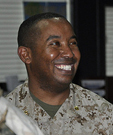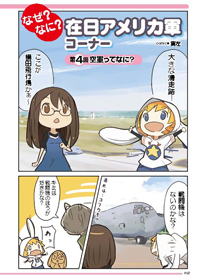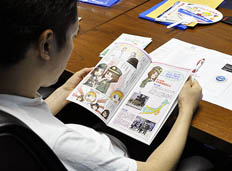
American View: Why did you choose manga to illustrate the U.S.-Japan Alliance?
Major Fisher: Well, manga wasn’t the only choice. As we approached the start of 2010, which was the fiftieth anniversary year, there was discussion to determine some ways to commemorate the anniversary year, and we actually came up with a list of about 25 different things. And it ran the gamut from parties and celebrations to bumper stickers, T-shirts, and manga. And of the 25 things, two were selected by the commander at the time, by General Rice. There was manga and a series of celebrations. And as the Deputy Director of Public Affairs, I became the action officer for the manga piece.
American View: What audience is the manga geared toward?
Major Fisher: The thought process behind choosing the audience was we wanted to focus on Japanese citizens who were (1) not very familiar with the alliance as a whole and (2) Japanese citizens who hadn’t quite made their mind up about how they feel about the U.S.-Japan Alliance, which meant we weren’t going to go too young because we didn’t want to hit an audience that it wouldn’t really register with and we didn’t want to go too old because after a certain age you kind of know what you think about things. So the initial audience was between 15 years old and about 35 years old. Now we found that after creating that huge age range that manga has certain audiences as well and you can find readers of manga from very young children to very old adults and we had to narrow it based on the type of artwork that we would use. So the artwork that we made the final decision to use really kind of hits an age group between late teens and upper twenties.

The fourth issue of the manga “Our Alliance – A Lasting Partnership”
American View: What were the steps in creating the manga?
Major Fisher: First step was to research manga. No one in USFJ Public Affairs really had any experience in manga so we had to figure out what it was, what was the draw. We had to determine why manga was important in Japan and we learned a lot. We learned that throughout the years, all aspects of life in Japan have been depicted in manga. Everything from hard material in terms of education through very light, social enjoyment type of reading, so though manga is a new concept in terms of conveying information for us in USFJ, it’s very common in pretty much all aspects of Japanese life.
American View: Who else was involved in the process?
Major Fisher: Everyone. All aspects of U.S. government in Japan, each of the major ministries that we work with in USFJ, specifically the Ministry of Defense (MOD) and Ministry of Foreign Affairs (MOFA), the U.S. Embassy, and a handful of folks outside of government who were just interested in manga and interested in the alliance and interested in how we’re conveying the messages. But that was pretty much the first step, a big first step. The second step was figuring how to do it.

Each issue of the manga focuses on one of the four branches of the U.S. military – the Army, Navy, Air Force, and Marines.
One of the things that made this a little easier is that manga is so pervasive in Japan it wasn’t hard to find companies that were interested in doing this work, so through the contracting process we requested bids from different manga companies and we selected the company that would be able to do the work in a timely fashion, but also a company that was familiar with military terminology and explaining political, military, and government issues in a manga format, and that’s how we ended up in the relationship with Hobby Japan that we have.
American View: Was that the company that designed the manga after you came up with the initial conception of it?
Major Fisher: Right. We have a two-part relationship. USFJ Public Affairs has the final say-so in the production, and that’s editing, content, artwork, etc. We lay out to Hobby Japan the road map that we want them to follow and then we make all of the editorial decisions in their creative process. So we decided we wanted to focus on the relationship between all of the U.S. forces in Japan and the Self-Defense Forces, and in doing so we would have a four-part series focusing on each of the respective services.
Hobby Japan took that guidance and worked through us to receive tours of different installations, command briefings, opportunities to photograph certain aspects of bases, equipment, military-to-military interactions, and then they would create the comic. And they would bring it to us for review and that review was pretty extensive. We went through three major reviews. One would be content; the second would be content and initial artwork, sketchwork; and the third review would be the full package of final artwork and content. And each one of those steps involved reviews from all of the interested parties throughout USFJ, the U.S. embassy, the Ministry of Defense, the Ministry of Foreign Affairs and in some cases even U.S. Pacific Command (PACOM) and Office of the Secretary of Defense (OSD) Public Affairs.

A Japanese student reads the U.S.-Japan Alliance manga.
American View: Did it start out in English or Japanese?
Major Fisher: It’s always been Japanese. Our audience in USFJ is the people of Japan, so none of the manga is in English and it was never the intent to make it in English.
American View: You mentioned that there were four issues that were released. What did each of those issues focus on?
Major Fisher: The first issue was the U.S. Army in Japan and their relationship with the Ground Self-Defense Force (GSDF). The second issue was the Marine Corps, and their relationship with the GSDF and the Maritime Self-Defense Force (MSDF). The third issue was the U.S. Navy and their relationship with the MSDF. And the final issue will be the U.S. Air Force and their relationship with the Air Self-Defense Force. And all of these issues kept the common theme or storyline of two specific characters, a young American boy, about 8 or 9 years old. His name is Usa-kun. It was kind of a play on words because the Japanese word for rabbit is “usagi.” If you notice in the manga he wears rabbit ears, so it’s a double entendre. It has two meanings – the “Usa” part representing the U.S. in the storyline, but also the rabbit ears with the usagi. The second character is Anzu, also a play on words. Her full name is Arai Anzu, which is “alliance” in Japanese. She’s about 13-14 years old. Little bit older, probably not that unusual in terms of other Japanese kids her age and their level of understanding of the alliance.
American View: How did you choose those two characters?
Major Fisher: Hobby Japan and their creative process. They brought the concept to us of using these two characters to bridge the issues and their thought process was that each issue would have three chapters. That first chapter would be a storyline that focused around Anzu and Usa-kun and their relationship and how they are learning about the alliance, the fifty-year alliance. Usa-kun is visiting Japan on what the Japanese call a “home -stay” and he lives with Anzu and her family over a period of time. During that time they learn about the alliance and that storyline continues from Issue 1 where they had very, very limited info about why the U.S. was in Japan, what was the alliance, very basic, and it has progressed up to Issue 4 where they are talking about specific treaties and how Americans in Japan influence life in Japan and vice versa and what it means to the overall alliance between the U.S. and Japan.
American View: How many copies of each issue were printed?
Major Fisher: Issue 1 was 20,000, and each of the remaining issues was 25,000.
American View: Where were the copies sent?
Major Fisher: To U.S. installations. To U.S. installations to be used during base visits, tours, and festivals. But also, the Ministry of Defense receives 2,000 copies of each issue that they send out to their prefectural offices. And then each of the different organizations that are interested in it receive copies – MOD, the Embassy, PACOM, OSD.
American View: Is there an online version?
Major Fisher: Yes. And it usually comes out faster than the actual hardcopy. All the versions are available on the USFJ website.
American View: Can a regular person request a copy?
Major Fisher: Not a hard copy because they’re limited. They need to visit a base to get a hard copy, but they’re all available online.
American View: What has been the response to the manga?
Major Fisher: Much higher than we anticipated. Right now we are over a million views of it online. It’s been viewed in over 90 countries around the world. To date we’ve issued close to 75,000 hard copies.
American View: Do you think with that reaction it’s been a more effective means of reaching readers than say traditional pamphlets and brochures?
Major Fisher: There’s a place for pamphlets and brochures. No one’s going to take the manga and make it the official USFJ means of communicating. It’s never been intended to replace the traditional forms of communication, it’s just something new. And fortunately the novelty of it has lasted up until hopefully this fourth issue. We suspect this fourth issue will be the largest draw because it is the last issue, and we’re already making preparations to create a single book that will have all four issues.
American View: What were some of the problems you encountered during its creation?
Major Fisher: The review process was difficult. Whenever you include the number of different organizations that we have listed there, getting everyone to agree to something when you’re crossing not only organizational lines but international political lines as well, that’s probably been one of the most delay-inducing challenges. Getting USFJ, the Embassy, PACOM, OSD, MOD, and MOFA to all agree on language is huge.
And then also there are the political implications as well. Everything means something. Despite how innocent the intent is, everything means something. In Issue 1, Usa-kun in his desire to protect Anzu and her house, he kills a roach, and one of the first questions that I received from the media was, “Which countries did the roach represent? Was the roach North Korea, was the roach China..?” It was a little eight year old kid who thought, “I’m American, I live with a Japanese family, I should be helping protect them like in the SOFA, or like in the treaty,” so he saw a roach and he killed a roach and it was as innocent as that, but in this political-military environment, this highly political environment, the roach meant something. That’s just one example. Every issue had a handful of those type of things. I promise you it’s totally innocent, but what people read into it is what they read into it.
American View: Manga has at times been viewed as sexist. How do you deal with that image?
Major Fisher: A lot of oversight from us and a lot of listening to people who are more familiar with manga than we are. My closest assistant in working on this whole manga project is a Japanese national. I use her sensibilities and her view on how certain issues are portrayed to try and balance out the desires of the artists because the company that does this manga, that’s their bread and butter. This isn’t their only manga project and they have a line of characters that are not necessarily characters that we would use in our USFJ manga. This is a business for them and they make every effort to keep the manga in line with what has worked for them and what has been popular for them and their readers. So it takes a lot of oversight from us to rein it back in, to make it a little more conservative.
We try to keep the manga a Japanese product, but we have to keep in mind that this is something that will be distributed from USFJ. As much as we try to keep the Japanese, we have to keep in mind that it’s still representing us, and that’s just consistently meeting with the artists, and the writers and keeping them in line with our intent. And it hasn’t been that hard. Their desire is to create manga that’s been popular for them. Whereas their audience is not necessarily the same audience that we want so we have to keep them in line with our wishes and the audience that we were looking for.
American View: Besides manga, what other things is the public affairs section involved in? How do you get your message out to the larger Japanese audience?
Major Fisher: Well, USFJ Public Affairs is not like other installations. Our primary mission is to help facilitate the messages of the alliance and that’s ensuring that we’re speaking in the same language as our counterparts within the government of Japan, specifically the Ministry of Defense and their public affairs section. We have a very close working relationship with them, specifically the Japan Joint Staff. We deal with Japan-wide issues.
American View: Is there anything else that I haven’t touched on that you would want to mention to readers of American View who are just hearing about the manga for the first time or about USFJ for the first time?
Major Fisher: If they’re interested in the manga, go to www.usfj.mil/manga and take a look at it. We are open to new things, and this was a clear example of that. What most people probably aren’t aware of is that the idea for this manga came from a group of colonels and a three-star general. It didn’t come from the young people in the building. This was just their having lived here in Japan for a number of years and seeing what’s popular and trying to come up with a way to tap into it in a manner that was true to its original design, in terms of manga, but also representative of USFJ.
Major Neal V. Fisher II is a graduate of Lewis University, Romeoville, IL, with a B.A. in Business Administration and Management. He was commissioned in the Marine Corps on April 2, 1998 via Officer Candidate Course, Marine Corps Combat Development Command, Quantico, VA. Major Fisher is a First Degree Black Belt and instructor in the Marine Corps Martial Arts Program and a Brown Belt in Okinawan Karate, Ueichi Ryu. He is currently stationed at Yokota Air Base as Deputy Director of Public Affairs for the United States Forces, Japan.







COMMENTS1
Thank you for pointing out the problem. We think that it’s been fixed. If you still see the same problem, please let us know. Thank you.
LEAVE A COMMENT
TOP